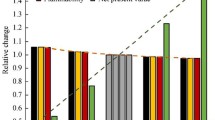Abstract
This paper addresses the problem of managing uncertainties in a safety-constrained process system for economic performance enhancement. Within such a context, a typical solvent selection problem involves a number of different solvents with nominal property values that are utilized in various process units and requires the minimization of the total operating cost while satisfying certain technical performance criteria and process safety constraints. Practically, in any process system, property values of streams are not exact; they are usually functions of operating variables and market conditions that change over time inevitably introducing irreducible uncertainties in system performance. A key aim of the present study is to systematically explore the effect of volatility in solvent prices on the economic performance of the process. Appropriate sensitivity analysis and Monte Carlo simulation work have been carried out to assist the decision maker in taking into account the continuously changing market conditions, while identifying operationally safe feasibility regions for solvents with different risk characteristics in the underlying optimization problem. The aforementioned uncertain inputs are shown to cause shifts of the associated Pareto front of optimal solutions toward feasibility regions that can be characterized in a more realistic manner. Finally, an illustrative case study that uses the permissible exposure limit as a risk factor is considered to evaluate the proposed method.













Similar content being viewed by others
References
Achenie LEK, Gani R, Venkatasubramanian V (2003) Computer-aided molecular design: theory and practice. Elsevier, Amsterdam
Curzons AD, Constable DC, Cunningham VL (1999) Solvent selection guide: a guide to the integration of environmental, health and safety criteria into the selection of solvents. Clean Prod Process 1:82–90
Elgue S, Prat L, Cabassud M, Cezerac J (2006) Optimisation of solvent replacement procedures according to economic and environmental criteria. Chem Eng J 117:169–177
El-Halwagi AM, Kazantzi V, El-Halwagi MM, Kazantzis N (2011) Optimizing safety-constrained solvent selection for process systems with economic uncertainties. Mary Kay O’Connor Process Safety Center, 2011 International Safety Symposium, College Station, Texas
Eljack F, Eden M, Kazantzi V, Qin X, El-Halwagi MM (2007) Simultaneous process and molecular design—a property based approach. AIChE J 35(5):1232–1239
Elmalik E, Tora E, El-Halwagi MM, Elbashir N (2011) Solvent selection for commercial supercritical Fischer–Tropsch synthesis process. Fuel Proc Technol 92(8):1525–1530
Folic M, Gani R, Jimenez-Gonzalez C, Constable DJC (2008) Systematic selection of green solvents for organic reacting systems. Chin J Chem Eng 16(3):376–383
Gani R, Jimenez-Gonzalez C, Constable DJC (2005) Method for selection of solvents for promotion of organic reactions. Comp Chem Eng 29:1661–1676
Giovanoglou A, Barlatier J, Adjiman CS, Pistikopoulos EN (2003) Optimal solvent design for batch separation based on economic performance. AIChE J 49(12):3095–3109
Harper PM, Gani R (2000) A multi-step and multi-level approach for computer aided molecular design. Comp Chem Eng 24:677–683
ICIS Pricing (2011). http://www.icis.com/StaticPages/a-e.htm. Accessed 1 Sept 2011
Jimenez-Gonzalez C, Curzons AD, Constable DJC, Cunningham VL (2005) Expanding GSK’s solvent selection guide—application of life cycle assessment to enhance solvent selections. J Clean Technol Environ Policy 7:42–50
Kazantzi V, Qin X, El-Halwagi MM, Eljack F, Eden M (2007) Simultaneous process and molecular design through property clustering—a visualization tool. Ind Eng Ch Res 46:3400–3409
Khan FI, Amyotte PR (2005) I2SI: a comprehensive quantitative tool for inherent safety and cost evaluation. J Loss Prev Process Ind 18:310–326
Marcoulaki EC, Kokossis AC (2000) On the development of novel chemicals using a systematic optimisation approach. Part II. Solvent design. Chem Eng Sci 55:2547–2561
OSHA’s regulations—standards section 29 CFR 1910.1000 Table Z-1. http://www.osha.gov/pls/oshaweb/owadisp.show_document?p_table=STANDARDS&p_id=9992. Accessed 22 Jan 2012
Patel SJ, Ng D, Mannan MS (2010) Inherently safer design of solvent processes at the conceptual stage: practical applications for substitution. J Loss Prev Process Ind 23:483–491
Pistikopoulos EN, Stefanis SK (1998) Optimal solvent design for environmental impact minimization. Comp Chem Eng 22(6):717–733
Pokoo-Aikins G, Heath A, Mentzer RA, Mannan MS, Rogers WJ, El-Halwagi MM (2010) A Multi-criteria approach to screening alternatives for converting sewage sludge to biodiesel. J Loss Prev Process Ind 23(3):412–420
Schrage L (2006) Optimization modeling with LINGO, 6th edn. LINDO Systems, Chicago
Vidal M, Rogers WJ, Holste JC, Mannan MS (2004) A review of estimation methods for flash points and flammability limits. Process Saf Prog 23(1):47–55
Vlysidis A, Binns M, Webb C, Theodoropoulos C (2011) A techno-economic analysis of biodiesel biorefineries: assessment of integrated designs for the co-production of fuels and chemicals. Energy 36(8):4671–4683
Wang Y, Achenie LEK (2002) A hybrid global optimization approach for solvent design. Comp Chem Eng 26:1415–1425
Acknowledgments
The authors would like to thank the anonymous reviewers for their valuable comments and helpful suggestions. Financial support from the National Science Foundation (NSF), USA through grant CTS-9403432 is gratefully acknowledged by Nikolaos Kazantzis.
Author information
Authors and Affiliations
Corresponding author
Rights and permissions
About this article
Cite this article
Kazantzi, V., El-Halwagi, A.M., Kazantzis, N. et al. Managing uncertainties in a safety-constrained process system for solvent selection and usage: an optimization approach with technical, economic, and risk factors. Clean Techn Environ Policy 15, 213–224 (2013). https://doi.org/10.1007/s10098-012-0516-z
Received:
Accepted:
Published:
Issue Date:
DOI: https://doi.org/10.1007/s10098-012-0516-z




